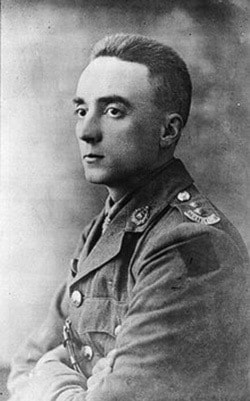Part six of a series looking at the history of Walhachin
World War I—which broke out in August 1914—was a global cataclysm that cost millions of lives, caused massive upheaval in Europe, and planted the seeds for an even bloodier conflict a little more than two decades later. But while the scale of the war was massive and unprecedented, few communities outside the theatre of war were affected by it to the extent that Walhachin, in the British Columbia interior, was.
As we have seen, the vast majority of the orchardists who settled in Walhachin were British, and many of them had military connections of some kind with regiments back in the Old Country. In 1911, other colonists without military connections in Great Britain formed the Walhachin Company of the 31st British Columbia Horse (now the British Columbia Dragoons).
When Britain declared itself to be at war on August 4, 1914, many of the Walhachin settlers who were affiliated with the military back home left to rejoin their regiments. The 20 members of the Walhachin Company of the 31st British Columbia Horse had been preparing for mobilization since June 1914, and in early August they were ordered to Quebec as part of the First Canadian Expeditionary Force. By the beginning of September, 43 men—including all but one of the single orchardists—had left Walhachin for active service, leaving only older and married men to continue working the land. Some of the married men also enlisted, often taking their families back to England with them, and by 1916 there were no English orchardists of military age—18 to 45 years old—left in Walhachin.

Members of the Walhachin Company of the 31st British Columbia Horse. Photo courtesy of the Ashcroft Museum and Archives.
When men began leaving Walhachin in August 1914, many of their wives left with them; in such a hurry that they took only what they could carry with them, leaving furniture, clothing, and personal items behind them. Perhaps these women were anxious to leave the “pioneer” lifestyle they had only adopted because their husbands had wanted it, and were eager to return to their home country. And there was also a very real feeling, in August 1914, that the war would be “over by Christmas”; so the women might have thought that it would be only a matter of weeks before they, and their husbands, would be able to return to the community.
But the war dragged on past Christmas 1914, and it soon became apparent to even the most casual observer that there would be no early end to it. More and more men joined up to fight, and in Walhachin that meant that there were a handful of older men, plus women and children and Chinese workers, to maintain the orchards that had been planted with so much promise a few years earlier.
The trees needed constant pruning, and had to be kept free from pests. In winter, ice had to be prevented from forming over the branches, and the wooden supports built to keep overladen branches from snapping at harvest time had to be maintained. Branches that were broken during severe storms needed to be removed, and damage to the trees needed to be repaired, so that the trees would not die. In autumn the fruit needed to be picked, and then packed for shipping.
It was exhausting and never-ending work, carried out by an ever-decreasing number of workers. Above all, there were concerns about the 12-mile long flume bringing the necessary water to the settlement from Deadman Creek. Flash floods wiped out trestles every spring, or destroyed a section of the trough, meaning that repairs were constantly needed, with fewer and fewer people there to make them.
Despite this, however, the orchards at Walhachin continued to live up to the promise of its earliest days, when the site was nothing but rocks and sand. The crop of 1914—which many of the orchardists had not been there to see—had been a bumper one, and the 1915 crop was of similar size. The 1916 crop was even better, and the 1917 and 1918 crops set records, with more than 1,500 boxes of apples produced.
The backdrop of this activity in Walhachin was what was happening with the community’s orchardists who were serving in the front lines in Europe. Walhachin colonists Gordon Flowerdew and Ralph Chetwynd—both members of the 31st British Columbia Horse in Walhachin—had been singled out for outstanding performances at a training camp held in Vernon in June 1912. Both men enlisted in August 1914, and Chetwynd was awarded the Military Cross and recommended for the Distinguished Service Order in 1918, for his action in rescuing his wounded colonel and carrying him to safety for two miles while enduring enemy fire.
Flowerdew was awarded the military’s highest honour—the Victoria Cross—for his actions on March 31, 1918. He had just returned to the lines after leave in England, and was in command of a cavalry charge northeast of the Bois de Moreuil in France. A citation in the London Gazette on April 24, 1918 stated that he had received the Victoria Cross for “most conspicuous bravery and dash when in command of a squadron detailed for special service of a very important nature.” Flowerdew led three troops in a charge on a heavily fortified German position, and despite being badly wounded continued to encourage his men, who captured their target.
In November 1917, Flowerdew wrote in his diary that he had been asked if he would like to win the V.C. “I replied ‘Yes, sir, I would. It has always been my dream. But I shall never be brave enough to win it. Valor has reached such a standard that you have to be dead before you win the V.C.’”
His words were prophetic. Walhachin’s Lieutenant Gordon Flowerdew died of his wounds on April 2, 1918, and his Victoria Cross was awarded posthumously.
To be continued
